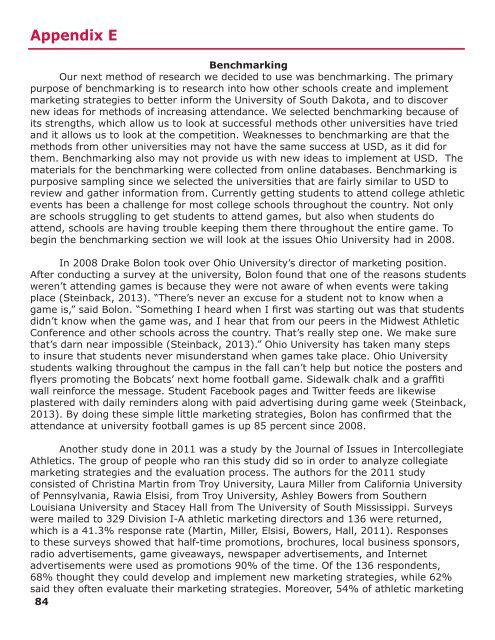CONSULTANTS
Create successful ePaper yourself
Turn your PDF publications into a flip-book with our unique Google optimized e-Paper software.
Appendix E<br />
Benchmarking<br />
Our next method of research we decided to use was benchmarking. The primary<br />
purpose of benchmarking is to research into how other schools create and implement<br />
marketing strategies to better inform the University of South Dakota, and to discover<br />
new ideas for methods of increasing attendance. We selected benchmarking because of<br />
its strengths, which allow us to look at successful methods other universities have tried<br />
and it allows us to look at the competition. Weaknesses to benchmarking are that the<br />
methods from other universities may not have the same success at USD, as it did for<br />
them. Benchmarking also may not provide us with new ideas to implement at USD. The<br />
materials for the benchmarking were collected from online databases. Benchmarking is<br />
purposive sampling since we selected the universities that are fairly similar to USD to<br />
review and gather information from. Currently getting students to attend college athletic<br />
events has been a challenge for most college schools throughout the country. Not only<br />
are schools struggling to get students to attend games, but also when students do<br />
attend, schools are having trouble keeping them there throughout the entire game. To<br />
begin the benchmarking section we will look at the issues Ohio University had in 2008.<br />
In 2008 Drake Bolon took over Ohio University’s director of marketing position.<br />
After conducting a survey at the university, Bolon found that one of the reasons students<br />
weren’t attending games is because they were not aware of when events were taking<br />
place (Steinback, 2013). “There’s never an excuse for a student not to know when a<br />
<br />
didn’t know when the game was, and I hear that from our peers in the Midwest Athletic<br />
Conference and other schools across the country. That’s really step one. We make sure<br />
that’s darn near impossible (Steinback, 2013).” Ohio University has taken many steps<br />
to insure that students never misunderstand when games take place. Ohio University<br />
students walking throughout the campus in the fall can’t help but notice the posters and<br />
<br />
wall reinforce the message. Student Facebook pages and Twitter feeds are likewise<br />
plastered with daily reminders along with paid advertising during game week (Steinback,<br />
<br />
attendance at university football games is up 85 percent since 2008.<br />
Another study done in 2011 was a study by the Journal of Issues in Intercollegiate<br />
Athletics. The group of people who ran this study did so in order to analyze collegiate<br />
marketing strategies and the evaluation process. The authors for the 2011 study<br />
consisted of Christina Martin from Troy University, Laura Miller from California University<br />
of Pennsylvania, Rawia Elsisi, from Troy University, Ashley Bowers from Southern<br />
Louisiana University and Stacey Hall from The University of South Mississippi. Surveys<br />
were mailed to 329 Division I-A athletic marketing directors and 136 were returned,<br />
which is a 41.3% response rate (Martin, Miller, Elsisi, Bowers, Hall, 2011). Responses<br />
to these surveys showed that half-time promotions, brochures, local business sponsors,<br />
radio advertisements, game giveaways, newspaper advertisements, and Internet<br />
advertisements were used as promotions 90% of the time. Of the 136 respondents,<br />
68% thought they could develop and implement new marketing strategies, while 62%<br />
said they often evaluate their marketing strategies. Moreover, 54% of athletic marketing<br />
84


